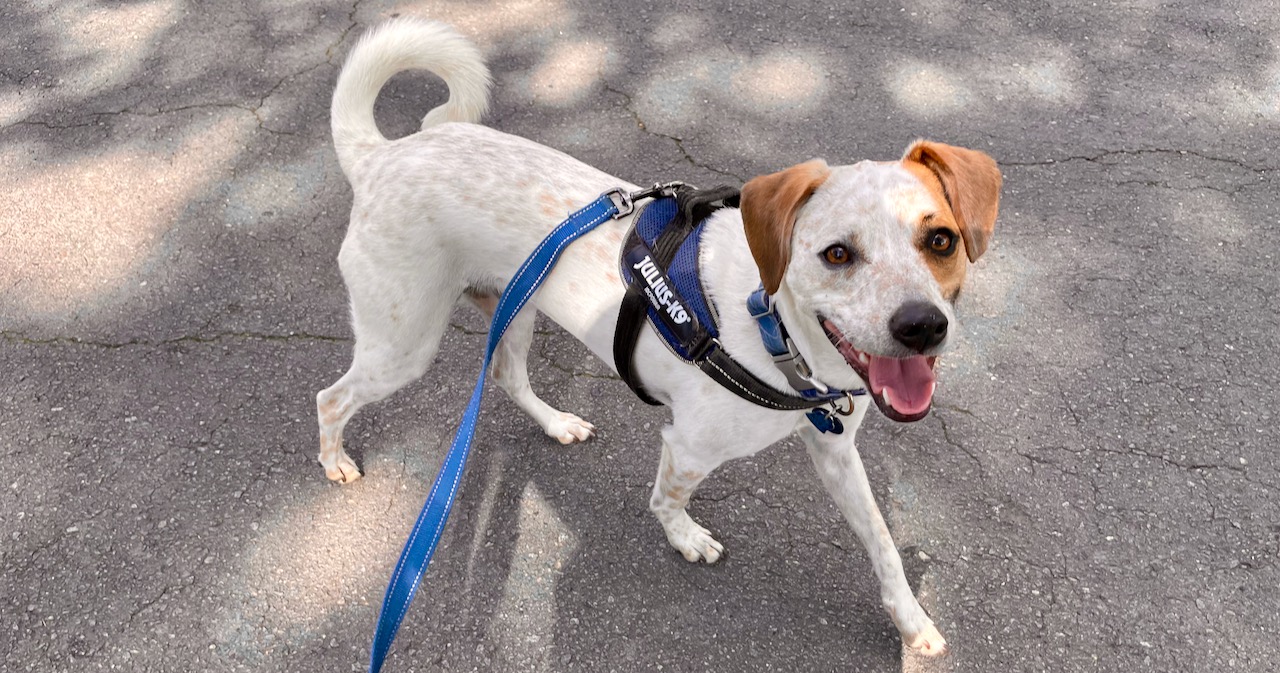Helping your beloved dog shed pounds and stay healthy
As with people, canine obesity has gradually become one of the greatest health challenges for many dogs. This article sheds light on the concerning trends of obesity in dogs and provides practical advice and suggestions on how to help your dog lose a few extra pounds if necessary.
The worry about canine obesity is not about appearance but genuine health concerns that can lead to joint issues, respiratory and heart problems, and metabolic disorders such as diabetes.
While some may find it endearing to see an overweight dachshund slowly waddling along on a dog walk, the reality is much different.
Obesity is also one of the top reasons for shorter lifespans in dogs. Studies have revealed that the lifespan of overweight dogs is up to 2 and a half years shorter than that of dogs with a healthy body weight.
My plan today is to answer the most common questions about canine obesity and ensure that you and other dog lovers are not robbed of precious years with your beloved pups.
Obesity, in general, is rather misperceived. I’ve heard so many people say they had to exercise more and eat less. I’ve also heard many say that no matter what they do, they or their dog can’t lose weight.
While drastically reducing calories and exercising may work, some people and dogs are able to remain slim within reasonable limits of food intake. Meanwhile, others can be challenged by sluggish or disrupted metabolisms, which make weight loss difficult.
How do you know if your dog is overweight or not?
Assess your dog’s weight according to the chart below. Feel the ribs and hips and see if your dog is under, over, or at the right weight. Make sure to account for the thickness of your dog’s coat.
If you can see your dog’s ribs, they are likely too thin. In long-haired dogs, you need to go by feeling the ribs, and by observing them when they are wet.
5 Reasons why dogs gain weight
Whenever a conversation veers towards the topic of weight gain and obesity, people generally blame themselves for overeating or not being active enough, but when it comes to dogs I see dog parents taking a different stance.
1. Emotional Factors of canine obesity. What is monkey love?
We love our dogs, and food is an expression of our love. It takes just one occasion of giving a dog food from the table, and the memory is forever etched into their brain. Next time, when dinner is served, no one can resist their pleading look.
Many dogs get fed whenever they ask, or their bowl is always filled with kibble. Unfortunately, the evolutionary path of dogs made them naturally ravenous. What if the next meal is a long time away?
My father used to say that if we can’t stop ourselves from doing something out of love despite it not being helpful, it is “monkey love.” But how can we resist those eyes?! Caring for and being kind to our dogs makes us feel good, and it leads to the release of feel-good hormones, which quickly turns us all into repeat “monkey love offenders.”
Solution: First, be kind to yourself, but do your best to feed your dog at predetermined times and treat them only on special occasions and when they are not asking. I learned that if I “drop” food when my dog Pax is not looking, the brain synapses between asking for and getting food do not form.
2. Feeding Frequency – once, twice, or whenever?
Based on my observations in veterinary practice, many dog parents find it challenging to feed their dogs once a day. Feeding two to three times per day is more common; however, it is much easier for dogs to maintain an optimal weight with one meal per day.
In addition, one meal a day is intermittent fasting, which activates the body’s DNA systems and allows the process of regeneration and cleansing, known to increase youth and longevity.
Solution: If someone feeds their chubby dog more than once a day, try reducing the size of one meal until it disappears. You will see that a gradual change will not upset your dog. In the worst-case scenario, your dog may be unhappy for a few days, but the long-term benefits are worth it.
3. The kind of food we feed
Most of us understand that the type and quality of food we feed our dogs matter. Much has been written about the issues dry kibble or processed canned food can cause.
The argument that kibble is scientifically formulated is mostly unfounded. All you need to do is look at the ingredients to see that most processed pet food companies completely ignore the natural diet of canines and make our dogs the victims of their corporate greed, similar to the tobacco industry.
Who are the people behind recipes that make no sense? I wonder who they are and often wish I could have an open conversation to answer one question:
Why do they think corn, wheat, fat, gluten meal, and poor quality by-products are okay for our four-legged family members?
Are they aware that their products shorten the average dog’s lifespan? Can they sleep at night?
But there are a few more issues with kibble and dehydrated food, with calorie density being at the top of the list. Dehydrated food is much more calorie-dense per volume. When dogs eat kibble or any form of dehydrated food, their stomach registers volume, not calories, making them eat much more than they would on natural food.
Over the years, the only overweight dogs I’ve seen were on kibble. It’s tough to make a dog fed a natural raw or home-cooked diet fat. They can’t eat enough to gain weight.
Solution: If your dog is overweight, try feeding it as much non-processed food as possible. Use the Healthy Dog Food Recipe Maker to create healthy recipes and determine the proper feeding amount. This tool is free for you to use and enjoy.
4. Insulin resistance – why obesity makes weight loss more difficult
Poor diet, insulin metabolism, and obesity are closely related. Processed food typically contains higher levels of carbohydrates. When your dog consumes high amounts of carbohydrates, they are broken down into glucose, which enters the bloodstream. In response, the pancreas releases insulin to facilitate glucose uptake by cells.
In a healthy individual, insulin helps maintain stable blood sugar levels by promoting glucose uptake into cells and storing excess glucose in the liver and muscles for later use. However, high or frequent consumption of carbohydrates causes spikes in glucose levels, which can contribute to insulin resistance, a condition in which the body’s cells become less responsive to insulin signals.
Insulin resistance can promote weight gain and make it difficult for individuals to lose weight. When cells are less responsive to insulin, glucose remains in the bloodstream, potentially leading to increased hunger and fat storage. Excess fat, particularly visceral fat (fat stored around the abdomen), can release inflammatory substances that further impair insulin action and promote insulin resistance.
A healthy diet, rich in whole foods, can help improve insulin sensitivity and reduce the risk of obesity and its associated health complications.
5. The link between the endocrine system (hormonal health) and canine obesity
Regular checkups by your veterinarian are important, especially to rule out hormonal conditions leading to obesity, such as hypothyroidism and Cushing’s disease.
However, I warn you against going with the recommendation of special processed weight loss diets that many veterinary clinics still carry. Knowing now what you know about obesity and weight loss, I will let you decide whether this example of the so-called “weight loss diet” makes any sense:
Chicken, Cracked Pearled Barley, Brown Rice, Pea Fiber, Corn Gluten Meal, Chicken Meal, Dried Tomato Pomace, Oat Fiber, Carrots, Chicken Liver Flavor, Flaxseed, Dried Beet Pulp, Coconut Oil, Pork Liver
To comment on this recipe, chicken is no longer lean due to breeding; the rest of the top ingredients are carbohydrates that are not a species-appropriate diet and contribute to obesity and insulin resistance.
Can physical activity be the remedy for obesity in dogs?
Exercise is undoubtedly vital for a dog’s health and longevity. However, it’s hard to shed weight if calorie intake isn’t reduced. This applies to dogs and people alike.
Eating 500 calories is easy, but it is very challenging to burn them off. For example, a person would have to do an hour of high-intensity interval training.
In other words, you can’t exercise your way out of a poor diet.
Intestinal microflora, probiotics, and obesity
In recent years, we’ve gradually started to recognize that a balanced intestinal microflora is essential for obesity prevention.
Research shows that certain probiotic strains can positively affect weight loss and help maintain optimal body weight by increasing microbiome diversity and promoting normal nutrient absorption and fat storage, often disrupted in obese dogs.
Maintaining a healthy gut and metabolism was one of my objectives when formulating GutSense and GutSense H+ — our canine and human probiotic supplements.
Combined with a balanced raw or cooked diet, probiotic supplementation can help your dog maintain a healthy body weight and increase longevity.
Final Thoughts
Throughout my years in veterinary practice, I’ve seen that the best way to prevent obesity is to feed your dog a species-appropriate, raw, or cooked diet of meat, raw bones, and raw vegetables once per day.
If your dog is overweight, include dog treats in the total amount calculated for their daily food intake, weigh your dog’s food, adjust it up or down by 20-25% if necessary, and check again in two to three weeks.
Good luck!
PS: If no weight loss happens, adjust further, but also check with your family members to see if they are not sneaking food behind your back. It is more common than you may think.
Dog obesity FAQs
Canine obesity is generally related to a high caloric intake due to processed food diets, metabolic disturbances, and insulin resistance. Obese dogs are also more likely to suffer from an imbalanced gut microbiome, which can result in excess body fat and inflammation.
-
Is dog obesity a problem?
While some might find chubby dogs quite endearing, obesity increases the risk of joint issues, respiratory and heart problems, and chronic conditions such as diabetes, lowering the quality of life for your pup. And it’s not only your dog’s health that suffers. Overweight dogs also have a shorter lifespan than those with a healthy body weight.
-
What is considered obese for a dog?
You can use the dog obesity chart above to assess your dog’s body weight at home. If you can’t see or feel their ribs and you notice rolls of fat along their back, your pup might fall in the obese category. Please consult your veterinarian if you’re concerned your dog might be overweight.
-
How do you fix obesity in dogs?
Maintaining a healthy weight starts with a balanced diet. Gradually switch your dog to a raw or cooked diet and support gut health with canine-specific probiotics to help reduce systemic inflammation, boost digestion and metabolism, and help reduce excess body fat.





